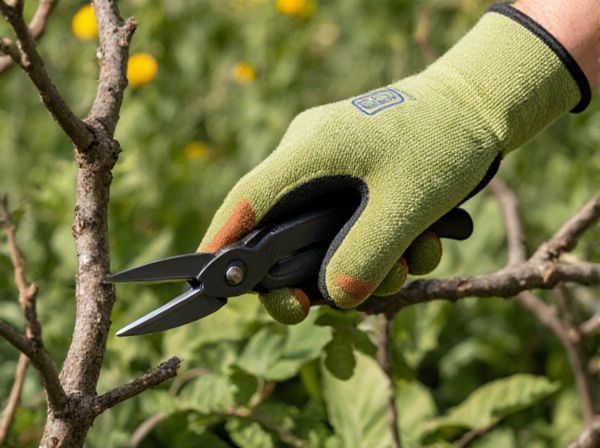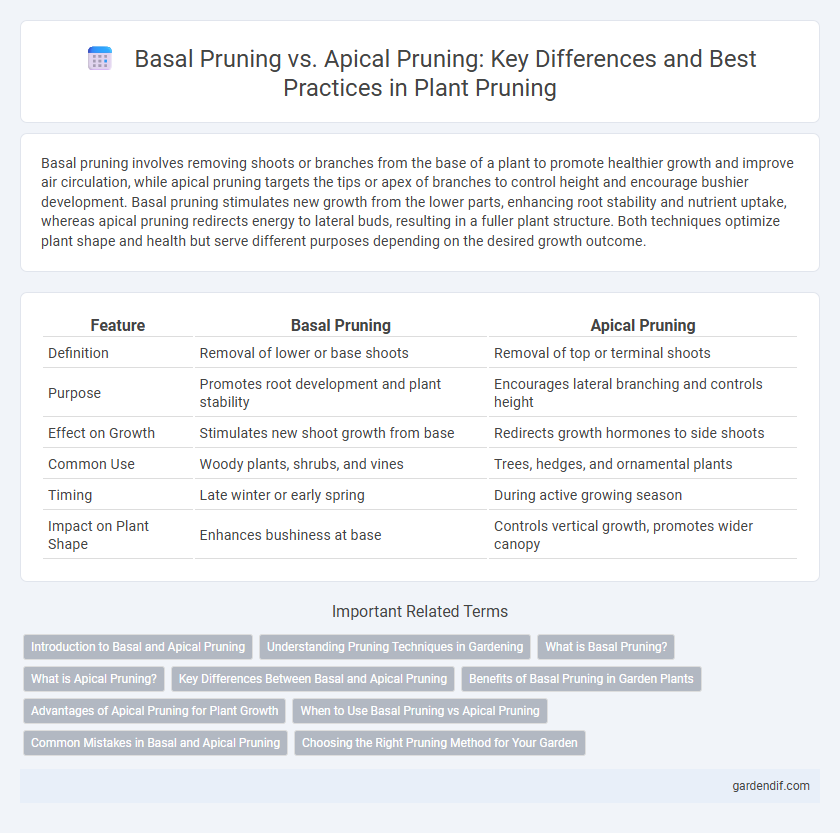
Basal Pruning vs Apical Pruning Illustration
Basal pruning involves removing shoots or branches from the base of a plant to promote healthier growth and improve air circulation, while apical pruning targets the tips or apex of branches to control height and encourage bushier development. Basal pruning stimulates new growth from the lower parts, enhancing root stability and nutrient uptake, whereas apical pruning redirects energy to lateral buds, resulting in a fuller plant structure. Both techniques optimize plant shape and health but serve different purposes depending on the desired growth outcome.
Table of Comparison
| Feature | Basal Pruning | Apical Pruning |
|---|---|---|
| Definition | Removal of lower or base shoots | Removal of top or terminal shoots |
| Purpose | Promotes root development and plant stability | Encourages lateral branching and controls height |
| Effect on Growth | Stimulates new shoot growth from base | Redirects growth hormones to side shoots |
| Common Use | Woody plants, shrubs, and vines | Trees, hedges, and ornamental plants |
| Timing | Late winter or early spring | During active growing season |
| Impact on Plant Shape | Enhances bushiness at base | Controls vertical growth, promotes wider canopy |
Introduction to Basal and Apical Pruning
Basal pruning involves removing shoots and branches from the lower part of a plant to improve air circulation and light penetration, enhancing overall plant health. Apical pruning targets the growth tips or apices to control plant height and encourage bushier development. Both techniques are essential for optimizing plant structure, promoting vigorous growth, and increasing yield quality in horticulture.
Understanding Pruning Techniques in Gardening
Basal pruning involves cutting shoots or branches near the base of a plant to promote healthy growth and increase airflow, reducing disease risk. Apical pruning targets the tips or apex of branches, encouraging bushier development and controlling the plant's height. Both techniques are essential for optimizing plant structure, enhancing photosynthesis, and improving overall garden yield.
What is Basal Pruning?
Basal pruning involves the removal of shoots and branches from the lower part of the plant or tree trunk to improve air circulation and light penetration at the base. This technique helps in reducing disease risk by eliminating crowded growth and encouraging healthy structural development. Basal pruning is commonly used in vineyards, orchards, and forestry to promote stronger plant architecture and optimize yield.
What is Apical Pruning?
Apical pruning refers to the selective removal of the terminal buds or shoots at the top of a plant's main stem, which regulates vertical growth and encourages lateral branching. This technique redistributes plant hormones such as auxins, reducing apical dominance and promoting bushier, fuller plant development. Apical pruning is commonly used in horticulture and arboriculture to shape plants, improve light penetration, and enhance overall plant health.
Key Differences Between Basal and Apical Pruning
Basal pruning targets the removal of shoots or branches from the lower part of the plant stem to encourage stronger root development and improve air circulation near the soil surface, while apical pruning involves cutting the top or apex of the plant to control height and promote lateral growth. Key differences include the impact on hormone distribution, with basal pruning stimulating cytokinin production for root growth and apical pruning reducing auxin levels to enhance branching. Basal pruning typically supports structural stability and nutrient uptake, whereas apical pruning primarily directs the plant's energy to shape its canopy and optimize light exposure.
Benefits of Basal Pruning in Garden Plants
Basal pruning enhances garden plants by stimulating robust root development and encouraging new, vigorous shoots at the base, leading to healthier overall growth. It improves air circulation and light penetration near the soil, reducing the risk of fungal diseases and pest infestations. This method supports stronger plant structure and increases flowering and fruiting potential in various garden species.
Advantages of Apical Pruning for Plant Growth
Apical pruning enhances plant growth by promoting vertical development and stronger stem structure through the removal of the shoot apex, stimulating lateral bud activation. This technique improves light penetration and air circulation within the canopy, reducing disease risk and encouraging more abundant flowering and fruiting. Compared to basal pruning, apical pruning leads to a more controlled and balanced growth pattern, optimizing overall plant health and productivity.
When to Use Basal Pruning vs Apical Pruning
Basal pruning is ideal for promoting new growth near the base of the plant, commonly used during early development stages to enhance structural strength and improve air circulation. Apical pruning targets the terminal buds, effectively controlling height and encouraging lateral branching, making it suitable for mature plants requiring shape maintenance. Selecting between basal and apical pruning depends on the plant's growth phase and desired outcome, with basal pruning favored for rejuvenation and apical pruning employed for size and form management.
Common Mistakes in Basal and Apical Pruning
Common mistakes in basal pruning include cutting too close to the main stem, which can cause damage and hinder regrowth, and removing too many basal shoots, leading to reduced plant vigor. In apical pruning, errors often involve cutting above the wrong node or excessively shortening the main leader, resulting in stunted growth and poor structural development. Understanding the correct pruning points is essential to promote healthy branching and maintain overall plant architecture.
Choosing the Right Pruning Method for Your Garden
Selecting the appropriate pruning method depends on the plant species and desired growth outcome, with basal pruning promoting vigorous new shoots from the base and apical pruning encouraging lateral branching. Gardeners aiming for fuller, bushier plants benefit from apical pruning, while basal pruning suits rejuvenating older plants or managing size. Understanding these effects ensures healthier growth and optimal garden aesthetics.
Basal Pruning vs Apical Pruning Infographic

 gardendif.com
gardendif.com